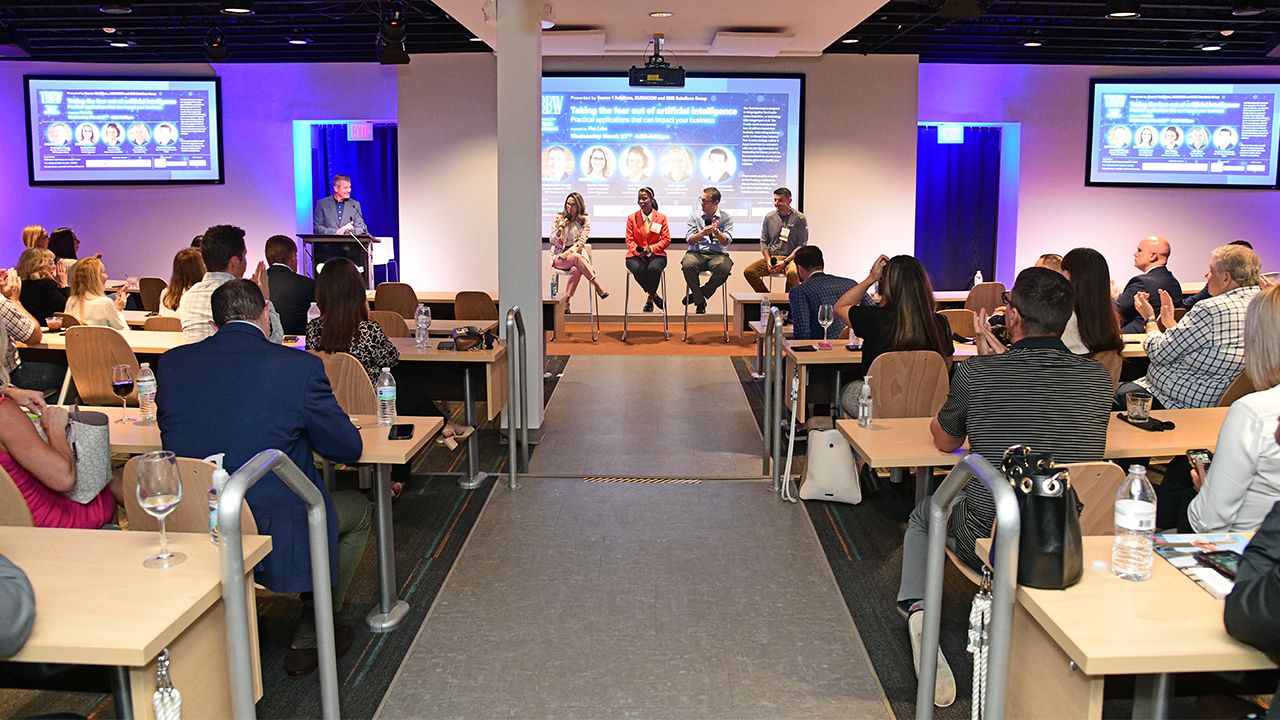Tampa Bay Business & Wealth held its second Tech Connect series panel discussion at American Stage in St. Petersburg.
This Tech Connect panel focused on the cross-departmental best practices between technology and marketing. The transcript has been edited for length and brevity.
The Panelists
• Matt Kemp, chief marketing officer, BlueGrace Logistics
• Tom Pierce, chief marketing officer, PSCU
• Dave Stafford, chief information officer, PSCU
• John Tonnison, executive vice president and chief information officer, Tech Data
• Pablo Zurzolo, vice president, Americas marketing, Tech Data
Chinnici-Everitt: I’m going to direct the first question to our CIOs in the group. Today, more than ever, technology is a true enabler of business growth. Companies across industries are in different stages of maturity and evolution. In thinking about your respective firms on this journey, between technology and marketing, would you characterize yourselves as a child, an adult in your early twenties or a fit, and active, middle age? And I am talking about your companies not you as individuals. So maybe Dave, do you want to start?
Stafford: I would say PSCU is probably a twenty-something who’s still living in the basement. [laughter] Seriously, we are a fairly mature organization. We’ve been in business for 40-plus years serving the same market. We serve credit unions and process car payments for financial institutions. So, we have a fairly mature operation both from a marketing perspective as well as our technology.
Tonnison: As the provider, I would say we’re a business that is very deeply transformed and advanced on the digital selling side, some $20 billion of our business is already digital commerce. Our digital marketing side has lagged that historically and as we will probably get into a little later, you’ll see that is the area of the more explosive, innovative and more disruptive activity using big data, federated systems and the real kind of digital transformation at the moment and is the area of our business that is getting the most value. It’s really kind of the guinea pig and leading the set of products in that area.
Kemp: We come from the transportation industry, which is hundreds of years old. We have competitors that are 100 years-plus old, multimillion-dollar, publicly-traded companies. We are very young in our industry, having just had our 10 year anniversary this year. We grew up, I would say like a lot of startups, in that we immediately gravitated to third party systems. Most of our technology would be leased and rented.
The system that we use to connect transactions to our customers is not our own. And one of the reasons that I’m now in this position is that is actually changing. So, we’ve made the decision going forward with a new equity partner that came on, just less than three years ago, to invest more heavily in technology and to build more proprietary systems so that when our equity partner turns around and sells the company, we will be more valuable. It will be much more valuable for us to have our own systems connect to our customers than an off the shelf one.
On the marketing side, the struggle for me has been that no one likes our systems. In fact, I have had senior sales executives tell me that they were able to complete a nine-month transaction from lead to customer without ever showing the customer our system because they were so embarrassed by it. And so, part of my job is to bridge those two things and create a proprietary system that the company can be proud of and that customers find easy to use.
Chinnici-Everitt: Pablo or Tom, would you like to add anything?
Pierce: I would agree with Dave that on the IT side we’re definitely mature. On the marketing side, I’d say we’re maturing. I think we’re still advancing a lot on the digital side. It’s an area that we’re growing and having to invest a lot more. It’s been an interesting challenge for us because I joined PSCU 18 months ago and we had a very proprietary-built series of websites that Dave and I agree, that they were not built in the right way. And about three months into my journey there, we had a situation where our web manager decided to leave without notice. It was Halloween night. So I called Dave, at 8 p.m. or 9 p.m., and said, can you please help and shut this guy out of the system so we can advance? And he wasn’t trick or treating thank goodness because we were able to handle it. But by working together, we’ve been able to transform some of those systems areas and be much more advanced from a digital perspective.
Zurzolo: In the Americas, we probably have about 25,000 customers and we have an audience of maybe 300,000 or 400,000. I would say we’re getting there in terms of sophistication to JT’s point, our foray from the marketing point of view, just on the shopping site, had always been about ads and funnel kind of tracking, rather than actual demand generation. Right? So, moving to demand generation, I’d say we’re pretty sophisticated. But there’s a lot left to learn. It’s more, I think, about getting actionable data rather than, just putting things on the platform and hoping that people come in [to it] and I guess consume it the way that you want them to.
Chinnici-Everitt: We’re going to transition a little and talk about strategies. A lot of times people will focus on technology because it’s new and it’s interesting, but it’s not a substitute for having a good strategy. So, unfortunately, sometimes that point may get lost in the debates. Do you ever encounter situations at your firms where technology is viewed as the solution to every problem and effectively becomes a substitute for strategy? And if that is the case, how do you combat that?
Tonnison: No, the alignment of our global functions to our business strategy is very clear that we exist to enable and power clearly defined strategies. You know, in the past that’s been heavily favored towards filling out of our line card capabilities, making sure the technologies can keep up with the growth of the company.
Our global corporate strategy has four pillars and one of them quite clearly is defined as digital transformation. I’m privileged to lead that digital transformation tower for the organization and be able to coordinate a number of functional and regional leaders in that area. Digital transformation is supplementing instead of [replacing] a business strategy. It’s also a significant part of powering the other three pillars, which are about our services and product breadth, our geography and about entry into new markets, which are themselves, technology markets.
Chinnici-Everitt: Great. Does anybody else have a different experience or perspective?
Stafford: The only thing I would add is in the case of PSCU, as we were building out our data practice, in probably 2005, when we started actually building data warehouses and so forth, it was primarily a technology-led initiative. And we built a big stack with a lot of data domains and the data scientists and the data governance folks were all technology. Just a few years ago we got to the point where we felt it was being dominated a bit by our tech folks. And we actually spun that group off into a separate division where today Tom doesn’t run data. I don’t run data, but it’s a business unit of its own that enables the product group, the marketing group and the tech group.
Kemp: In our industry, historically, technology hasn’t been on the front edge. We are doing logistics, which is a fairly messy business that takes a lot of manual processes. So, there is some new entrance into our industry because they have immediately adopted technologies, which are known as digital freight matching that have gotten a lot of buzz and high valuations. But we would probably disagree that the technology is the sort of panacea to solving the world’s trucking problems. Technology can be used to automate manual processes, but there’s always going to be a need to build relationships with the customers and the carriers in our business. And that’s sort of where we see our strategy, more on the relationship side, and then the technology supplements those relationships.
Zurzolo: The only other thing I would add to your question is about how to make sure that your investment in tools maps your strategy. I think as marketers, a lot of us are often challenged with showing tangible benefits for investments that we make in technology. And you just have to have the courage to go ahead and do it. At Tech Data, nothing gets signed off on that doesn’t have both an alignment to the strategy, but also a tangible revenue or profit criteria. Things are proposed, but they never see the light of day if they actually don’t have some kind of tangible benefits. As marketers, I think we just need to be courageous with what we think this technology will be able to bring and very specific as to how we think that’s going to happen and monitor it. If it doesn’t work, it doesn’t work, but at least you’ve put a stake in the ground.
Chinnici-Everitt: I talked a little bit earlier about the importance of collaboration between the CIO and the CMO. So how would you characterize your working relationships with your counterparts across the organization?
Zurzolo: I’ve had two careers at Tech Data. I was here for eight or nine years. I left for about 10, and then I came back five years ago. And when I came back, my predecessors who had been in the job before me had developed a brand an unintentional brand, within IT, as being the shadow IT guys. My predecessors had gone off and bought a whole bunch of stuff, without necessarily caring about how the IT department would view that kind of investment or if it was risky from a cyber point of view. So, I remember coming back, and I had known JT from my previous time, and I told him, “you guys are the shadow IT guys and you have to change that.”
I would say that the way that that’s developed is even more critical now, when you think about privacy and compliance issues, that as marketers it changes the way we do digital marketing, or it should. The only other person who cares as much about security and privacy as I do is actually JT and the IT organization. So, I think we’ve been forced into having to work together. But in the past, I don’t know that it was the most positive relationship. IT was more worried about making sure that things got executed 99.9 percent of the time, and uptime and all these things about our site. And I was much more worried about, but where’s the AD going to be?
But one of the things JT did early on, from a digital commerce point of view, was to make sure that his digital leader, our digital leader and the marketing digital leader were aligned in design. ♦
[image_slider_no_space height=”300″ images=”7684,7683,7682,7681,7680,7679,7678,7677,7676,7675,7674,7673″]













